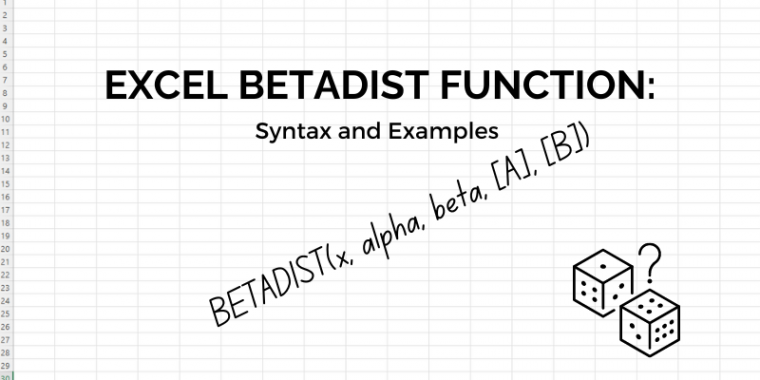
Excel’s BETADIST function is an essential tool for statisticians and data analysts, offering the capability to calculate the cumulative beta distribution function. This function is particularly useful in financial modeling, project management, and quality control, where understanding the behavior of random variables and probability distributions is crucial. In this article, we’ll delve into the specifics of the BETADIST function, including its syntax, parameters, and practical examples to illustrate its application.
What is the BETADIST Function?
The BETADIST function in Excel calculates the cumulative beta probability density function. This function is typically used to model variables that have a finite range and is useful in scenarios where you want to understand the distribution of probabilities over a specific interval.
Syntax
The syntax for the BETADIST function is straightforward:
BETADIST(x, alpha, beta, [A], [B])
- x: The value at which to evaluate the function. It must be a value between A and B.
- alpha: A parameter of the distribution, often related to the shape of the distribution.
- beta: Another parameter of the distribution, also affecting the shape of the distribution.
- A: An optional parameter representing the lower bound of the interval of x. If omitted, it is assumed to be 0.
- B: An optional parameter representing the upper bound of the interval of x. If omitted, it is assumed to be 1.
Parameters Explained
- x (Required): This is the point at which the cumulative beta distribution function is evaluated. The value of x should lie between the lower and upper bounds (A and B).
- alpha (Required): This parameter defines the shape of the beta distribution. It is a positive number and, along with the beta parameter, shapes the distribution curve.
- beta (Required): Like alpha, this parameter influences the shape of the distribution. It is also a positive number.
- A (Optional): This is the lower bound of the interval for x. If not provided, Excel assumes it to be 0.
- B (Optional): This is the upper bound of the interval for x. If not provided, Excel assumes it to be 1.
Practical Examples
Let’s explore some practical examples to understand how the BETADIST function works in real scenarios.
Example 1: Basic Usage
Suppose we want to calculate the cumulative beta distribution function for a value of 0.5 with alpha and beta parameters both set to 2. We’ll assume the default interval [0, 1].
code=BETADIST(0.5, 2, 2)
In this case, the function will return a value of 0.5, indicating that 50% of the data lies below 0.5 in this beta distribution.
Example 2: Custom Interval
Consider calculating the beta distribution for a value of 3 within a custom interval [1, 5], with alpha and beta set to 2 and 3, respectively.
code=BETADIST(3, 2, 3, 1, 5)
Here, the function evaluates the cumulative beta distribution within the specified interval [1, 5], providing a precise understanding of the probability distribution within this range.
Example 3: Comparing Different Distributions
To illustrate the impact of different alpha and beta parameters, let’s compare two beta distributions with different shapes.
For alpha = 2 and beta = 5:
code=BETADIST(0.4, 2, 5)
For alpha = 5 and beta = 2:
code=BETADIST(0.4, 5, 2)
These examples show how varying the alpha and beta parameters affect the cumulative distribution function, highlighting the flexibility of the BETADIST function in modeling different types of distributions.
Common Errors and Troubleshooting
- #VALUE! Error: This error occurs if any of the arguments are non-numeric.
- #NUM! Error: This error is seen if the provided x value is outside the specified interval [A, B], or if the alpha or beta parameters are non-positive.
Ensure that all input values are within the expected range and that alpha and beta parameters are positive to avoid these errors.
Conclusion
The BETADIST function in Excel is a powerful tool for statisticians and analysts, providing a robust method to model and analyze beta distributions. By understanding its syntax and parameters, you can leverage this function to gain deeper insights into your data and make more informed decisions based on probability distributions. Whether you’re working on financial models, quality control charts, or project risk assessments, the BETADIST function can enhance your analytical capabilities in Excel.
